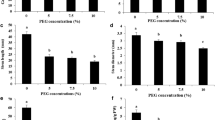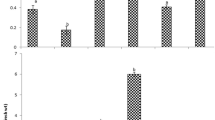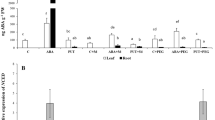Abstract
Polyamines (PAs) are ubiquitous polycations involved in many physiological processes in plants, including somatic embryogenesis, cellular growth and stress reactions. In the present study, we focus on the consequences in PA metabolism caused by polyethylene glycol (PEG) in proembryogenic Scots pine (Pinus sylvestris L.) liquid cultures. The growth and viability of the cell masses and changes in PA concentrations and phenolic secondary metabolites were investigated under control, 5 and 10 % PEG treatments. The effect of osmotic stress responses was investigated at the gene expression level including stress, cell division, programmed cell death and PA-related genes and PA metabolites. Moreover, the expression of ethylene and proline biosynthesis genes and phenylalanine ammonia lyase and stilbene synthase (psSTS) was analyzed. Under osmotic stress conditions, we found a consistent pattern of endogenous PAs in Scots pine proembryogenic cells. However, accumulation of free spermine (Spm) and methyl putrescine under osmotic stress might indicate their specific role in stress protection. Expression of polyamine oxidase was down-regulated under osmotic stress, suggesting the role of PA catabolism in regulation of Spm levels. Scots pine proliferating proembryogenic cells are in a developmentally undifferentiated stage where the content of secondary metabolites is generally low. However, in the present study the total content of phenolic compounds increased but the biosynthesis of phenylpropanoids and stilbenes, generally considered as stress-protective molecules, was not affected by osmotic stress.






Similar content being viewed by others
References
Aronen T, Pehkonen T, Ryynänen L (2009) Enhancement of somatic embryogenesis from immature zygotic embryos of Pinus sylvestris. Scan J For Res 24:372–383
Astarita LV, Guerra MP (2000) Conditioning of culture medium by suspension cells and formation of somatic proembryo in Araucaria angustifolia (Conifereae). In Vitro Cell Dev Biol Plant 36:194–200
Bassard JE, Ullmann P, Bernier F, Werck-Reichhart D (2010) Phenolamides: bridging polyamines to phenolic metabolism. Phytochemistry 71:1808–1824
Boudet AM (2007) Evolution and current status of research in phenolic compounds. Phytochemistry 68:2722–2735
Butland SL, Chow ML, Ellis BE (1998) A diverse family of phenylalanine ammonia-lyase genes expressed in pine trees and cell cultures. Plant Mol Biol 37:15–24
Chong J, Poutaraud A, Hugueney P (2009) Metabolism and roles of stilbenes in plants. Plant Sci 177:143–155
Cona A, Rea G, Angelini R, Federico R, Tavladoraki P (2006) Functions of amine oxidases in plant development and defense. Trends Plant Sci 11:80–88
Cvikrová M, Binarová P, Eder J, Vágner M, Hrubcová M, Zoń J, Machácˇková I (1999) Effect of inhibition of phenylalanine ammonia-lyase activity on growth of alfalfa cell suspension culture: alterations in mitotic index, ethylene production, and contents of phenolics, cytokinins, and polyamines. Physiol Plant 107:329–337
Cvikrová M, Malá J, Hrubcová M, Eder J, Zoń J, Machácˇková I (2003) Effect of inhibition of biosynthesis of phenylpropanoids on sessile oak somatic embryogenesis. Plant Physiol Biochem 41:251–259
Cvikrová M, Malá J, Hrubcová M, Eder J, Foretová S (2008) Induced changes in phenolic acids and stilbenes in embryogenic cell cultures of Norway spruce by culture filtrate of Ascocalyx abietina. J Plant Dis Prot 115:57–62
Desvoyes B, de Mendoza A, Ruiz-Trillo I, Gutierrez C (2014) Novel roles of plant Retinoblastoma-Related (RBR) protein in cell proliferation and asymmetric cell division. J Exp Bot 65:2657–2666. doi:10.1093/jxb/ert411
Dutra NT, Silveira V, Azevedo IG, Gomes-Neto LR, Façanha AR, Steiner N, Guerra MP, Floh EIS, Santa-Catarina C (2013) Polyamines affect the cellular growth and structure of pro-embryogenic masses in Araucaria angustifolia embryogenic cultures through the modulation of proton pump activities and endogenous levels of polyamines. Physiol Plant 148:121–132
Elmaghrabi AM, Ochatt S, Rogers H, Francis D (2013) Enhanced tolerance to salinity following cellular acclimation to increase NaCl levels in Medicago truncatula. Plant Cell Tissue Organ Cult 114:61–70. doi:10.1007/s11240-013-0306-2
Everette JD, Bryant QM, Green AM, Abbey YA, Wangila GW, Walker RB (2010) A thorough study of reactivity of various compound classes towards the Folin–Ciocalteu reagent. J Agric Food Chem 58:8139–8144. doi:10.1021/jf1005935
Fitzmaurice GM, Laird N, Ware JH (2004) Applied longitudinal analysis. Wiley, Hoboken
Fliegmann J, Schröder G, Schanz S, Britsch L, Schröder J (1992) Molecular analysis of chalcone synthase and dihydropinosylvin synthase from Scots pine (Pinus sylvestris), and differential regulation of these and related enzyme activities in stressed plants. Plant Mol Biol 18:489–503
Fornalé S, Sarjala T, Bagni N (1999) Endogenous polyamine content and metabolism in the ectomycorrhizal fungus Paxillus involutus. New Phytol 143:581–587
Godoy-Hernández GC, Vázquez-Flota F, Loyola-Vargas V (2000) The exposure to trans-cinnamic acid of osmotically stressed Catharanthus roseus cells cultured in a 14 L bioreactor increases alkaloid accumulation. Biotechnol Lett 22:921–925
Gupta PK, Durzan DJ (1985) Shoot multiplication from mature trees of Douglas-fir (Pseudotsuga menziesii) and sugar pine (Pinus lambertiana). Plant Cell Rep 4:177–186
Häggman H, Vuosku J, Sarjala T, Jokela A, Niemi K (2006) Somatic embryogenesis of pine species—from functional genomics to plantation forestry. In: Mujib A, Samaj J (eds) Somatic embryogenesis. In series: plant cell monographs, vol 2. Springer, Berlin, pp 119–140
Häggman H, Pirttilä AM, Niemi K, Sarjala T, Julkunen-Tiitto R (2009) Medicinal properties, in vitro protocols and secondary metabolite analyses of Scots Pine. Methods Mol Biol 547:35–52
Hatmi S, Trotel-Aziz P, Villaume S, Couderchet M, Clément C, Aziz A (2014) Osmotic stress-induced polyamine oxidation mediates defence responses and reduces stress-enhanced grapevine susceptibility to Botrytis cinerea. J Exp Bot 65:75–88
Hong Z, Lakkinen K, Zhang Z, Verma DPS (2000) Removal of feedback inhibition of delta(1)-pyrroline-5-carboxylate synthetase results in increased proline accumulation and protection of plants from osmotic stress. Plant Physiol 122:1129–1136
Klimaszewska K, Noceda C, Pelletier G, Label P, Rodriguez R, Lelu-Walter MA (2009) Biological characterization of young and aged embryogenic cultures of Pinus pinaster (Ait.). In Vitro Cell Dev Biol Plant 45:20–33
Lorenz WW, Sun F, Liang G, Kolychev D, Wang H, Zhao X, Cordonnier-Pratt MM, Pratt LH, Dean JFD (2005) Water stress-responsive genes in loblolly pine (Pinus taeda) roots identified by analyses of expressed sequence tag libraries. Tree Physiol 26:1–16
Lu J, Vahala J, Pappinen A (2011) Involvement of ethylene in somatic embryogenesis in Scots pine (Pinus sylvestris L.). Plant Cell Tiss Organ Cult 107:25–33. doi:10.1007/s11240-011-9952-4
Luna CM, Pastori GM, Driscoll S, Groten K, Bernard S, Foyer CH (2004) Drought controls on H2O2 accumulation, catalase (CAT) activity and CAT gene expression in wheat. J Exp Bot 56:417–423
Mhamdi A, Noctor G, Baker A (2012) Plant catalases: peroxisomal redox guardians. Arch Biochem Biophys 525:181–194
Michel RE, Kaufmann MR (1973) The osmotic potential of polyethylene glycol 6000. Plant Phys 51:914–916
Mikula A, Niedzielski M, Rybczynsky JJ (2006) The use of TTC reduction assay for assessment of Gentiana spp. cell suspension viability after cryopreservation. Acta Physiol Plant 28:315–324
Miller G, Suzuki N, Ciftci-Yilmaz S, Mittler R (2010) Reactive oxygen species homeostasis and signaling during drought and salinity stress. Plant Cell Environ 33:453–467
Minocha R, Smith DR, Reeves C, Steele KD, Minocha SC (1999) Polyamine levels during the development of zygotic and somatic embryos of Pinus radiata. Physiol Plant 105:155–164
Miskolczi P, Lendvai Á, Horváth GV, Pettkó-Szandtner A, Dudits D (2007) Conserved functions of retinoblastoma proteins: from purple retina to green plant cells. Plant Sci 172:671–683
Moschou PN, Roubelakis-Angelakis K (2013) Polyamines and programmed cell death. J Exp Bot. doi:10.1093/jxb/ert373
Moschou PN, Paschalidis KA, Delis ID, Andriopoulou AH, Lagiotis GD, Yamakoumakis DI, Kalliopi A, Roubelakis-Angelakis KA (2008) Spermidine exodous and oxidation in the apoplast induced by abiotic stress is responsible for H2O2 signatures that direct tolerances in tobacco. Plant Cell 20:1708–1724
Moschou PN, Wu J, Tavladoraki P, Angelini R, Roubelakis-Angelakis KA (2012) The polyamines and their catabolic products are significant players in the turnover of nitrogenous molecules in plants. J Exp Bot 63:5003–5015. doi:10.1093/jxb/ers202
Muilu-Mäkelä R, Vuosku J, Läärä E, Häggman H, Saarinen M, Heiskanen J, Sarjala T (2015) Water availability influence morphology, mycorrhizal associations, PSII efficiency and polyamine metabolism at early growth phase of Scots pine seedlings. Plant Phys Biochem 88:70–81
Pinheiro J, Bates D, DebRoy S, Sarkar D and the R Development Core Team (2012) nlme: linear and nonlinear mixed effects models. R package version 3.1-103
Pottosin I, Shabala S (2014) Polyamines control of cation transport across plant membranes: implications for ion homeostasis and abiotic stress signaling. Front Plant Sci 5:1–15. doi:10.3389/fpls.2014.00154
Qiu J, Yoon JH, Shen B (2005) Search for apoptotic nucleases in yeast: role of Tat-D nuclease in apoptotic DNA degradation. J Biol Chem 280:15370–15379
R Development Core Team (2012) R: a language and environment for statistical computing. R Foundation for statistical computing, Vienna, Austria. http://www.R-project.org/. ISBN 3-900051-07-0
Romani A, Ieri F, Turchetti B, Mulinacci N, Vincieri FF, Buzzini P (2006) Analysis of condensed and hydrolysable tannins from commercial plant extracts. J Pharm Biomed Anal 41:415–420
Shen X, Wang Z, Song X, Xu J, Jiang C, Zhao Y, Ma C, Zhang H (2014) Transcriptomic profiling revealed an important role of cell wall remodeling and ethylene signaling pathway during salt acclimation in Arabidopsis. Plant Mol Biol 86:303–317
Silveira V, Balbuena TS, Santa-Catarina C, Floh EIS, Guerra MP, Handro W (2004) Biochemical changes during seed development in Pinus taeda L. Plant Growth Regul 44:147–156
Silveira V, Santa-Catarina C, Tun N, Scherer G, Handro W, Guerra M, Floh E (2006) Polyamine effects on the endogenous polyamine contents, nitric oxide release, growth and differentiation of embryogenic suspension cultures of Araucaria angustifolia (Bert.) O. Ktze. Plant Sci 171:91–98
Singleton VL, Orthofer R, Lamuela-Raventos RM (1999) Analysis of total phenols and other oxidation substrates and antioxidants by means of Folin–Ciocalteu reagent. Methods Enzymol 299:152–178
Skirycz A, Claeys H, De Bodt S, Oikawa A, Shinoda S, Andriankaja M, Maleux K, Eloy NB, Coppens F, Yoo SD, Saito K, Inze D (2011) Pause-and-stop: the effects of osmotic stress on cell proliferation during early leaf development in arabidopsis and a role for ethylene signaling in cell cycle arrest. Plant Cell 23:1876–1888
Stasolla C, van Zyl L, Egertsdotter U, Craig D, Liu W, Sederoff RR (2003) The effects of polyethylene glycol on gene expression of developing white spruce somatic embryos. Plant Phys 131:49–60
Swinnen IAM, Bernaerts K, Dens EJJ, Geeraerd AH, Van Impe JF (2004) Predictive modelling of the microbial lag phase: a review. Int J Food Microbiol 94:137–159
Tavladoraki P, Rossi MN, Saccuti G, Perez-Amador MA, Polticelli F, Angelini R, Federico R (2006) Heterologous expression and biochemical characterization of a polyamine oxidase from Arabidopsis involved in polyamine back conversion. Plant Phys 141:1519–1532
Tiburcio AF, Altabella T, Bitrián M, Alcázar R (2014) The roles of polyamines during the lifespan of plants: from development to stress. Planta. doi:10.1007/s00425-014-2055-9
Towill LE, Mazur P (1975) Studies on the reduction of 2,3,5-triphenyl tetrazolium chloride as a viability assay for plant tissue cultures. Can J Bot 53:1097–1102
Viitala K, Potila H, Savonen E-M, Sarjala T (2011) Health from forest-antioxidative properties of endophytic fungi from Scots pine roots. Proceedings of the 7th international conference on mushroom biology and mushroom products (ICMBMP7)
Vuosku J (2011) A matter of life and death—polyamine metabolism during zygotic embryogenesis of pine. PhD thesis, Acta Universitatis Ouluensis, Scientiae rerum naturalium 573, Oulu, Finland
Vuosku J, Jokela A, Läärä E, Sääskilahti M, Muilu R, Sutela S, Altabella T, Sarjala T, Häggman H (2006) Consistency of polyamine profiles and expression of arginine decarboxylase in mitosis during zygotic embryogenesis of Scots pine. Plant Phys 142:1027–1038
Vuosku J, Sarjala T, Jokela A, Sutela S, Sääskilahti M, Suorsa M, Läärä E, Häggman H (2009) One tissue, two fates: different roles of megagametophyte cells during Scots pine embryogenesis. J Exp Bot 60:1375–1386. doi:10.1093/jxb/erp020
Vuosku J, Suorsa M, Ruottinen M, Sutela S, Muilu-Mäkelä R, Julkunen-Tiitto R, Sarjala T, Neubauer P, Häggman H (2012) Polyamine metabolism during exponential growth transition in Scots pine embryogenic cell culture. Tree Phys 32:1247–1287
Vuosku J, Sutela S, Kestilä J, Jokela A, Sarjala T, Häggman H (2015) Expression of catalase and retinoblastoma-related protein genes associated with cell death processes in Scots pine zygotic embryogenesis. BMC Plant Biol 15:88. doi:10.1186/s12870-015-0462-0
Wi SJ, Kim SJ, Kim WT, Park KY (2014) Constitutive S-adenosylmethionine decarboxylase gene expression increases droughty tolerance through inhibition of reactive oxygen species accumulation in Arabidopsis. Planta. doi:10.1007/s00425-014-2027-0
Yamaguchi K, Takahashi Y, Berberich T, Imai A, Takahashi T, Michael AJ, Kusano T (2007) A protective role for the polyamine spermine against drought stress in Arabidopsis. Biochem Biophys Res Commun 352:486–490
Zapata JM, Salinas C, Calderón AA, Muñoz R, Ros Barceló A (1991) Reduction of 2,3,5-triphenyltetrazolium chloride by KCN-insensitive salicylhydroxamic acid-sensitive alternative pathway of mitochondria from cultured grapevine cells. Plant Cell Rep 10:579–582
Acknowledgments
We are grateful to Ms. Eeva Pihlajaviita, Ms. Anneli Käenmäki and Ms. Hanna Leppälammi for their skillful technical help. We thank Meeri Pearson for proofreading the manuscript. This research was funded by the Thule Institute (2010–2013) (to HH), Academy of Finland (Project 121994 to TS) and Graduate School of Forest Sciences (to RMM).
Conflict of interest
The authors declare that they have no conflict of interest.
Author information
Authors and Affiliations
Corresponding author
Electronic supplementary material
Below is the link to the electronic supplementary material.
Rights and permissions
About this article
Cite this article
Muilu-Mäkelä, R., Vuosku, J., Hamberg, L. et al. Osmotic stress affects polyamine homeostasis and phenolic content in proembryogenic liquid cell cultures of Scots pine. Plant Cell Tiss Organ Cult 122, 709–726 (2015). https://doi.org/10.1007/s11240-015-0805-4
Received:
Accepted:
Published:
Issue Date:
DOI: https://doi.org/10.1007/s11240-015-0805-4




